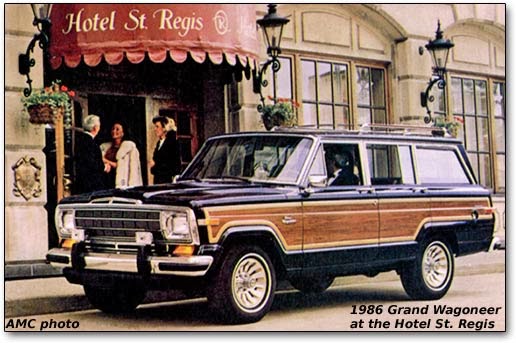One possible reason is that Jeep passed through several corporate hands over the more than 70 years of production. The original design was by the American Bantam (formerly, American Austin) company. But the Butler, Pennsylvania firm was judged to be too small to produce Jeeps in sufficient numbers for America's army, so production contracts went to Willys and Ford.
Postwar, Willys continued Jeep production while introducing civilian versions. Eventually, Willys was taken over by Kaiser. When Kaiser failed, the marque was continued by American Motors which, in turn, was absorbed by Chrysler, that is now part of Fiat. Jeep survived all this because it was a distinctive brand selling vehicles whose use was understood. In recent years, Jeeps have not all been off-road-capable utility vehicles. Instead, many models are simply SUVs similar to those made by other firms. Yet the grille design theme continues.
Weaponized Jeep - C. 1942
This might even be a 1941 photo, from the look of the uniforms. This particular Jeep is overloaded with a heavy machine gun and what seems to be a 37 mm cannon or anti-tank gun. No doubt this is a publicity photo intended to extoll Jeep's potential combat versatility.
Bantam Reconnaissance Car - c. 1940
Here is one of the original American Bantam Jeeps. The grille is simply a set of vertical bars protecting the radiator (sort of).
Willys MA - 1941
This is an early Willys Jeep. In addition to radiator protection bars, the Willys name is stamped on the front of the hood.
Jeep at Yalta Conference - 1945
The Jeep shown here with President Roosevelt in the passenger seat has the grille configuration most commonly found in World War 2 and associated with Jeeps ever since.
Willys Jeepster - c. 1948
Willys introduced "civilianized " Jeeps not long after the war. Vertical grille bars painted body color are overlain by chromed horizontal bars, perhaps an attempt to add sleekness to the design.
Willys Station Wagon - 1951
Here is the station wagon version. Same grille, but the rest of a car is an ur-SUV (as Germans might put it).
Jeep Wagoneer - 1963
A new body design approaching conventional styling for the time. The main unconventional features are the flat front and vertical grille. That grille contains traditional Jeep vertical slots, but narrower, and in a chromed panel.
Jeep Cherokee - 1974
A decade later, this Cherokee model sports a horizontal grille containing many Jeep-style vertical slots.
Jeep Cherokee - 1985
Another decade later, we see this Cherokee with squared-off vertical slots and a pattern behind them. Still Jeep-like in general effect, however.
Jeep Grand Wagoneer - 1986
That's the St. Regis hotel on East Grand Boulevard in Detroit. It's across the street from what was then the headquarters for General Motors. GM put me up there once, back when I started consulting for them. This Jeep's grille has a vertically oriented grid pattern behind the horizontal chromed bars. The Jeep grille is gone, for all practical purposes. Perhaps stylists or management thought that the boxy body was sufficient to visually identify the brand.
Jeep Liberty - c. 2002
By 1990, Jeep grilles were back to their traditional mode. This Liberty even maintains the grille-headlamp positioning of World War 2 Jeeps such as the one pictured above at Yalta.
Jeep Cherokee - 2014
Here is the latest Jeep grille interpretation, this on a new SUV design in line with current body sculpting fashion. Maybe I'll change my mind, but right now I rather like this variation on the traditional Jeep grille because, while it's clearly Jeep-like, it has a contemporary flair.












1 comment:
Additionally Jeep was part of Mercedes when Chrysler Corporation was involved with them. We have a 2007 Jeep Grand Cherokee that I am told has suspension elements from Mercedes C Class.
Post a Comment